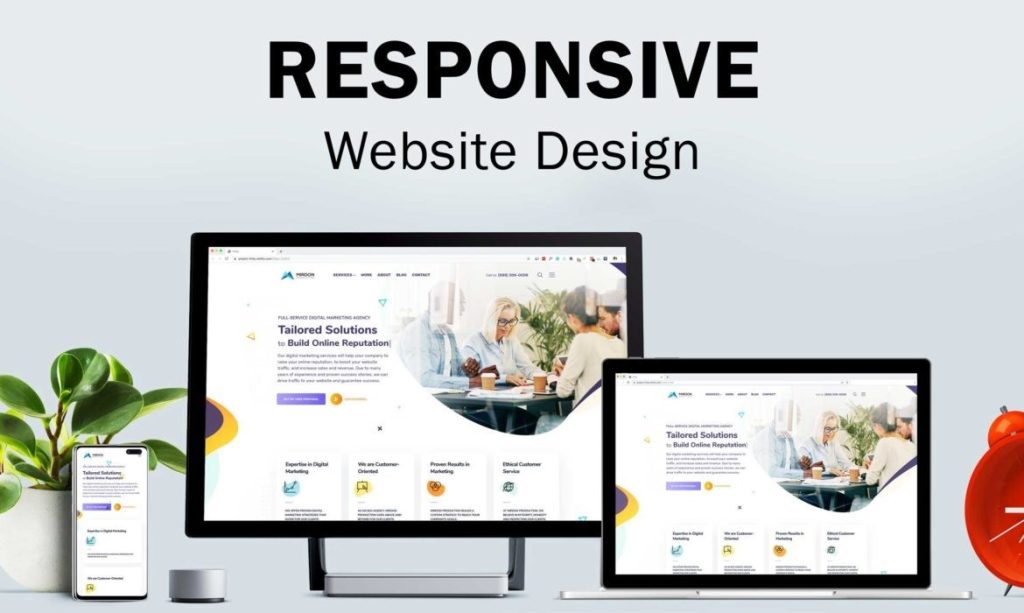
Moreover, a responsive website can positively impact your search engine rankings. Search engines prioritize sites that offer a good user experience on all devices. By adopting responsive design, you not only improve accessibility but also boost your online visibility.
In this article, we will explore the key principles of responsive design, the benefits it offers, and the common mistakes to avoid. We will also discuss tools and resources that can aid you in creating a responsive website. As technology continues to evolve, understanding these concepts will help you stay ahead and meet the needs of your audience.
What is Responsive Website Design?
Responsive Website Design refers to an approach that allows websites to adapt seamlessly to different screen sizes and devices. It aims to provide an optimal viewing experience for users, regardless of the device they are using. As more people access the internet on smartphones and tablets, having a responsive design becomes essential. A site that adjusts to various screen sizes improves usability and keeps visitors engaged.
With responsive design, your website will automatically adjust its layout based on the user’s device. This adaptability minimizes the need for separate mobile sites. Additionally, a single, responsive site simplifies management and maintenance. Moreover, Google prioritizes responsive sites in search rankings. Therefore, using responsive design can boost your visibility online.
You might wonder how responsive design works. It uses flexible grids and fluid images, along with CSS media queries. These elements allow the website to detect the device’s screen size and adjust accordingly. As a result, visitors enjoy a consistent experience. They can easily navigate, read content, and interact with your site.
Furthermore, responsive design can positively impact your business. It enhances user satisfaction, which can lead to higher conversion rates. Studies show that 70% of consumers abandon websites that are not mobile-friendly. By investing in responsive design, you can retain more visitors and ultimately drive more sales. Your website will become a more effective tool for reaching your audience.
Benefits of Responsive Design
Responsive Website Design offers several benefits that can significantly impact your online presence. First, it greatly improves user experience. When visitors access your site on different devices, they expect a seamless experience. If your website is responsive, it adjusts easily to their screen size. As a result, users can read content and navigate with ease. This convenience leads to longer visit durations and lower bounce rates.
Moreover, responsive design positively affects your search engine optimization (SEO) rankings. Google prefers responsive sites because they provide a better user experience. When your site ranks higher, more potential customers can discover your business. In fact, studies indicate that mobile-friendly websites are more likely to rank well on search engines. Therefore, adopting responsive design can give you a competitive advantage.
In addition, responsive design increases mobile traffic. More people browse the internet on mobile devices than ever before. If your site is mobile-friendly, it becomes more accessible to this audience. Higher mobile traffic can translate into more leads and sales. Furthermore, responsive websites require less maintenance than separate mobile sites. This efficiency allows you to focus more on growing your business.
Ultimately, investing in Responsive Website Design is a smart choice. It not only enhances user experience but also boosts your SEO and attracts more visitors. By prioritizing responsive design, you create a more effective online presence that supports your business goals.
Key Principles of Responsive Design
Key principles of Responsive Website Design focus on creating a seamless experience across different devices. One foundational concept is flexible grids. These grids use relative units like percentages instead of fixed sizes. By doing this, your layout can adapt to various screen sizes. This flexibility allows elements to resize proportionally, making your website more accessible.
Another important principle is fluid images. When you use fluid images, they resize automatically based on the screen dimensions. This approach prevents images from overflowing their containers, which could disrupt the layout. You can achieve this by setting the image’s maximum width to 100%. As a result, images remain sharp and relevant on all devices.
Media queries also play a vital role in responsive design. These CSS techniques allow you to apply specific styles based on device characteristics. For example, you can change font sizes or layouts depending on whether users are on mobile or desktop. This targeted approach enhances user experience by tailoring the website to their needs.
By incorporating these principles, you create a more user-friendly environment. Responsive Website Design not only improves accessibility but also boosts engagement. When visitors have a positive experience, they are more likely to return. Overall, understanding these foundational concepts will help you build a successful and responsive website.
Common Mistakes to Avoid
When implementing Responsive Website Design, businesses often make common mistakes that can hinder their success. One frequent pitfall is neglecting to test the site on various devices. Many companies assume their design will look good on all screens without thorough testing. However, this can lead to unexpected issues that frustrate users. To avoid this mistake, conduct regular testing on multiple devices and screen sizes.
Another mistake involves overloading the website with unnecessary elements. Some businesses add too many features, which can slow down loading times. A cluttered layout may also confuse visitors. Instead, focus on a clean, simple design that highlights key information. This clarity will improve user experience and keep visitors engaged.
Moreover, ignoring the importance of content hierarchy is a common error. Businesses often fail to prioritize information, making it hard for users to find what they need. Ensure that essential content stands out clearly. Use headings and subheadings to guide visitors through your site effectively. This organization will make your website more intuitive and user-friendly.
Finally, remember that responsive design is not a one-time project. Many businesses assume that once they implement it, they can forget about it. However, regularly updating your site and monitoring its performance is crucial. By staying proactive, you can adapt to changing user needs and technology trends. Avoiding these pitfalls will help you create a more effective and engaging responsive website.
Tools and Resources for Responsive Design
When creating a responsive website, various tools and resources can simplify the process. One popular framework is Bootstrap. This front-end framework offers a grid system and pre-designed components. By using Bootstrap, you can quickly develop responsive layouts without starting from scratch. This tool is especially useful if you are looking to save time.
Another valuable resource is Foundation. Similar to Bootstrap, Foundation provides responsive design elements and a flexible grid system. It allows for extensive customization, making it a good choice for unique projects. You can also use CSS Grid and Flexbox for layout design. Both are modern CSS techniques that enable responsive adjustments. They give you precise control over how elements resize and reposition.
For testing your responsive design, BrowserStack is an excellent option. This tool lets you test your website across different browsers and devices. You can identify and fix issues before launching your site. Additionally, Google’s Mobile-Friendly Test helps you assess how well your site performs on mobile devices. It provides insights that can guide your design improvements.
Furthermore, design tools like Adobe XD and Figma allow you to prototype and design responsive layouts. These tools enable collaboration and help you visualize how your site will look on various screens. By utilizing these tools, you can create effective Responsive Website Design that meets user needs. Overall, these resources will support you in building a successful, responsive website.
Future Trends in Responsive Design
Future trends in Responsive Website Design are evolving rapidly, driven by emerging technologies and changing user behaviors. One significant trend is the rise of AI-driven design tools. These tools can analyze user preferences and behavior to suggest design adjustments. As a result, you can create more personalized experiences for your visitors. This level of customization can boost user engagement and satisfaction.
Another important trend is the growing emphasis on voice search optimization. As smart speakers and voice assistants become more common, your website must adapt. Voice search often relies on natural language processing, which requires a different approach to content. Therefore, you should focus on conversational keywords and clear answers to user queries. Optimizing for voice search can improve your website’s visibility and accessibility.
Moreover, the use of progressive web apps (PWAs) is gaining traction. PWAs combine the best of websites and mobile apps, offering a smooth experience across devices. They load quickly and can function offline, providing added value to users. Incorporating PWAs into your responsive design strategy can enhance usability and performance.
Finally, the trend toward minimalism continues to shape responsive design. Users prefer clean and simple interfaces that highlight essential information. A minimalist approach not only improves user experience but also ensures faster loading times. By embracing these future trends, you can create a more effective and engaging Responsive Website Design that meets evolving user needs.
Conclusion
In conclusion, Responsive Website Design is essential for creating effective online experiences. It helps you cater to users across various devices and screen sizes. By implementing key principles such as flexible grids and fluid images, you can enhance user engagement. Additionally, avoiding common pitfalls will keep your design process efficient and focused.
As technologies evolve, staying informed about future trends will also benefit your website. AI-driven design tools and voice search optimization are just a couple of areas to explore. Furthermore, adopting progressive web apps can provide users with a smoother experience.
Ultimately, investing in Responsive Website Design is investing in your audience’s satisfaction and your business’s success. By prioritizing a responsive approach, you set your website up for continued relevance and growth in the digital landscape.


